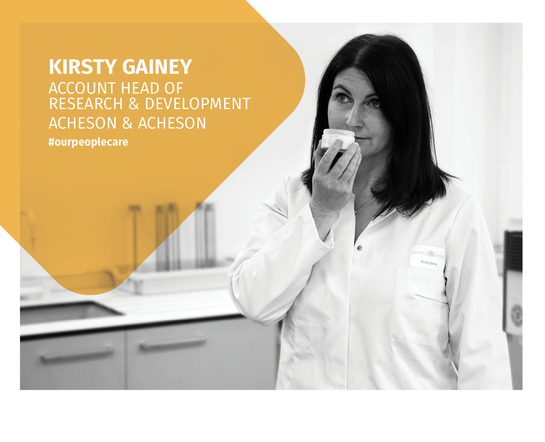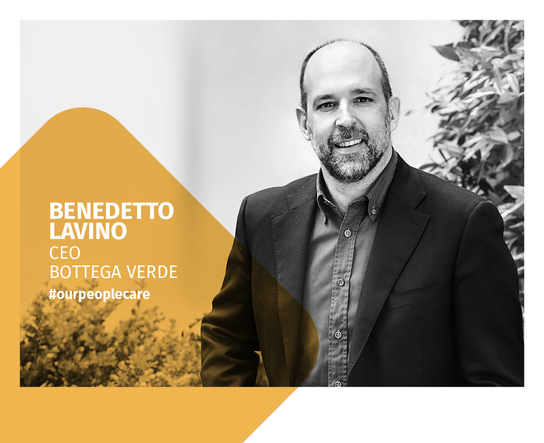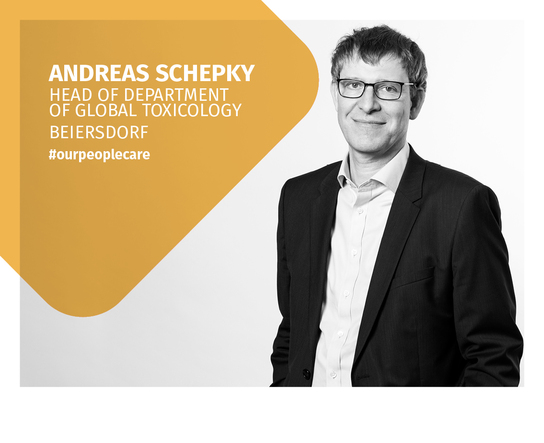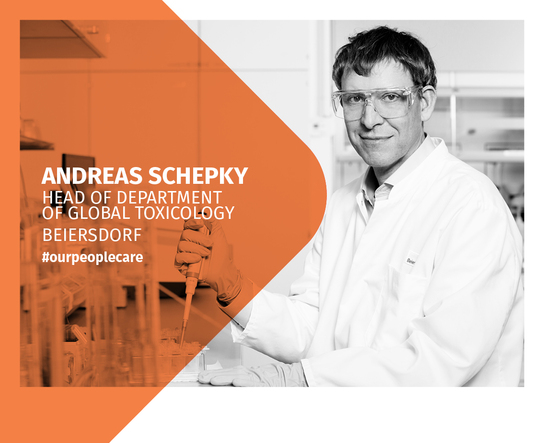The European cosmetics and personal care industry supports over 2 million jobs up and down the value chain.
Our sector employs a wide array of professionals from scientists, to regulatory specialists, to communication and marketing experts and many more, making our industry extremely diversified in terms of potential career pathways and opportunities.
Below meet some of Our People and find out what it means for them to work for the cosmetics industry.

Kirsty Gainey’s career might have been very different. Her first love was geology, and throughout her teens, she had wanted to be a palaeontologist. But as fate would have it, when newly introduced university fees in the UK forced her to postpone secondary education in order to raise funds, she found work as a lab technician. She discovered quickly that cosmetic science was her real calling.
As Account Head of Research and Development at Acheson and Acheson, a full-service, product development and manufacturing company in the United Kingdom, Kirsty is responsible for a team of chemists and technicians who formulate and develop products.
“When you’re a scientist in the cosmetics industry, you’re effectively combining several sciences in a single career.”
In other words, her team looks after cosmetics products, from conception right through to production, to make sure they are launched legally, safely and on time.
Kirsty therefore has a 360° view of how science is applied in our industry. When asked what is different about being a scientist in the cosmetics industry, she highlights the sheer breadth of her role. You’re effectively able to combine several sciences in a single career. One day it might be biology, when working on the presentation of a skin care product. The next day, when in the lab trying to dissect a manufacturing problem, it’ll be chemistry, and even botany, given the growing number of botanical ingredients being used in cosmetics.
Another difference, according to Kirsty, is the artistry and creativity involved. Scientists in our industry create textures and colours, which requires a sense of what works visually in addition to a deep knowledge of the science.
Knowing what is trending far beyond the four walls of the laboratory is also a prerequisite. Fashions shift all the time, so scientists also need to have their fingers on the pulse of what consumers want, from changing aesthetics through to greener products.
Ensuring that products are safe for consumers is Kirsty’s foremost responsibility. Followed closely by innovating to discover new ingredients. Innovation never stops in the cosmetics industry. It cannot: consumer tastes and expectations constantly evolve, and we need to keep up.
One major industry trend is the shift towards biotechnology. Kirsty and her team are constantly on the look-out for new raw materials that might be transformed into ingredients they can use in cosmetics products.

Kirsty is currently engaged in a project with a local raw materials supplier to support the development of oils that have never been used in cosmetics production before. It is expert work, with teams of agronomists and farming experts employed over years to ensure that the right procedures for optimal growth are followed. The aim is that the oils might, for instance, be high in a specific compound which could be good for the skin.
When the process does succeed the result can be highly rewarding. Though it was hard to pick just one, the single project Kirsty has worked on in her career that makes her most proud was for a high street retailer in the UK that sells both cosmetics and food products. Looking to create an ingredient from food waste, they worked with a local university and a UK wine producer that supplied the same retailer, taking left over pulp from grapes used for the wine and transforming it into a high-end anti-oxidant material which formed the basis of a skincare product marketed by the same retailer!
Beyond the excitement inherent in working at the intersection of science, fashion and innovation, Kirsty loves the human aspect of her job. Across the spectrum of specialities, from raw materials providers through to toxicologists right through to branding experts, the cosmetics industry is close-knit.
“We are a close-knit industry. Although we work for different companies, we are always very happy to collaborate and share knowledge, especially within the realm of safety.”
While companies do of course compete, they are very happy to collaborate and share knowledge, especially within the realm of safety.
Moreover, there are so many small companies in the cosmetics industry, be it raw materials providers, distributors or smaller brands. Working closely with them and seeing them grow, in part thanks to what they are learning from Kirsty and her colleagues, is a source of pride and satisfaction.
As is Kirsty’s role in the ‘Scrub up on Science’ programme, which aims to get secondary-school children excited about science, especially chemistry. She speaks at events at various schools across the UK, like the recent science, technology, engineering, and mathematic (STEM) fair where she spoke to around 350 girls from many local schools in a single day. She finds that most students relate to the cosmetics industry quite easily as they all use products to some extent but have not thought about the science involved in their creation. They frequently go away feeling energised and enthusiastic when they understand the intricacies involved in creating many of the products they use every day.
This encapsulates the appeal of Kirsty’s job, and the reason she remains so motivated: the science is broad and exciting, but in addition, it is used to manufacture and test products which people find indispensable, and use every day of their lives.

Thousands of exceptional small and medium sized businesses help drive our industry across Europe. Some of them grow into larger companies, while retaining the family flavour of their formative years, such as Benedetto Lavino’s family business, Bottega Verde.
The origins of the business did not indicate that it would one day become the leading Italian producer of cosmetics made from natural active ingredients. But our industry has long been one in which entrepreneurs have thrived. Benedetto’s family has a long history of entrepreneurship, first in the mail order business with various B2B and B2C catalogues, before it eventually landed in cosmetics in the early 1990s.
Benedetto joined the company in 1997 to help build its new retail presence and to set up an eCommerce arm from scratch. Benedetto cites the latter as a major turning point in his career, as he learned the importance of going digital: how it can support relationship-building with customers, and its role in maintaining a lean operation.
“Digital is key to success as it can support relationship-building with customers, and help maintain a lean operation.”
To be successful, company leaders need to do things differently. Benedetto has done so throughout his career.
At the start, he was able to apply the family’s distance selling experience to build an intimate relationship with the company’s customers through data mining, segmentation and personalised communication. This would take place online, but also in shops, where information would be captured about visitors who would then be contacted with customised special offers, which was unheard of in Italy in the 1990s.
Another of Benedetto’s ‘secret ingredients’ is the company’s ties to the territory and community in which the products originate. A selection of ingredients that go into the products – mainly oats, olive oil, grapes – are grown by local farmworkers on a 180-hectare plot owned by the Lavino family in the Tuscan countryside. These are all then utilised in Bottega Verde’s own facilities, also based locally, where products are manufactured, and R&D is conducted in the search for the next great ingredient.
The fact that he leads this full-cycle process, from growing the raw materials through to manufacturing, is a big motivating factor. It means Bottega Verde employ locally and contribute to protecting local biodiversity, and thus play a part in supporting the community. Moreover, as Bottega Verde remains a family enterprise, long term planning is more important than quarterly reviews, allowing Benedetto to make business decisions that will benefit the company, environment, and community far into the future.

While Benedetto did feel the urge to forge his own path, back in the 1990s when he went to work for a Spanish telecommunications firm for 3 years, the lure was too strong. Will his kids one day join? Maybe, but only if that is where their dreams take them, and they have the right skillset and attitude to succeed.
“Being a family enterprise, long term planning is more important than quarterly reviews. I can make business decisions that will benefit the company, environment, and community far into the future.”
Benedetto believes that family members in well-run companies need to work much harder to prove themselves and to set the bar high, so his three sons certainly would not have an easy ride were they to join!
Indeed, while work-life balance is important for Benedetto, the hours are long. When not travelling, spending quality time with the family in the mornings and evenings is paramount, but the working day starts at 8 and finishes at around 7. There is plenty of travel in the schedule though, from shop openings, to trips to cosmetics fairs around the world, and engagements relating to his board roles at the Italian Cosmetics Association, where he is Vice President, as well as the Italian eCommerce Association and the Italian Franchising Association.
What does the future hold for Benedetto? His overriding goal is enhancing sustainability. He firmly believes that businesses and the individuals who lead them have a responsibility to reduce their carbon footprints.
“We have a responsibility to reduce our carbon footprints. This starts with knowing what that footprint is and closing the production loop as far as possible.”
And this starts with knowing what that footprint is and closing the production loop as far as possible in order to control and measure all aspects of it. While he is proud of the progress he has made so far, more can always be done. This will be Benedetto’s driver for years to come.

Dr. Andreas Schepky always knew he wanted to be a scientist. His father worked in research and development for the pharmaceutical industry, meaning science, and scientists, featured prominently in his life from an early age. His enthusiasm for the same pursuit has lasted to this day: for more than 20 years, he has worked at Beiersdorf on the development of innovative alternative testing methods for product safety assessments.
As Head of Department of Global Toxicology, Andreas drives the development and use of alternative methods to animal testing at Beiersdorf, leading 3 laboratories. Beyond his lab work, he is a prolific author.
“The safety of cosmetics is secured by making sure that every ingredient used in them is safe.”
Last year alone, he wrote or co-wrote 10 peer-reviewed papers, and reviewed many more. Andreas has also taken time to pursue further post-graduate studies in his field: he received a Master of Applied Toxicology with distinction from the University of Surrey, United Kingdom, in 2016, which involved intensive studies in parallel to his full-time job.
“The complexity of alternative methods demands this level of commitment. Our products are easy to use but the processes for developing them and guaranteeing that they are absolutely safe for consumers are most certainly not. The safety of cosmetics is secured by making sure that every ingredient used in them is safe,” Andreas emphasises. “And generating data for each and every ingredient using alternative methods requires an array of complex techniques, both in the lab and increasingly on computers,” he adds.
Given the high quality and safety standards for cosmetics, projects can take several years to complete. Indeed, it took more than ten years of dedicated work on a project on alternative methods in the area of skin sensitisation to develop the method from scratch and to comprehensively test and validate it. Andreas cites this as his proudest achievement, as his team was honoured with an award by the German Federal Ministry of Food, Agriculture and Consumer Protection. “It is due in large part to endeavours such as these that our industry has become one of the world’s leaders in alternative methods to animal testing,” he says.
Andreas stresses that work on alternative methods in our industry began long before most people probably assume, and before animal testing was banned for cosmetics in Europe.
“Our pioneering scientists were developing alternative methods even before it was commonplace in other industries.”

“Our pioneering scientists were committed to developing alternative methods even before it was commonplace in other industries. A dedicated community of scientists proactively drove this shift due to ethical persuasions, coupled with the science-based conviction that alternatives would actually be the better predictors. It is our stated goal to advance research to the point when alternative approaches can cover all toxicological aspects and are accepted and used for regulatory decision-making globally,” he says.
And things are about to get even more exciting. Andreas speaks with great enthusiasm about technologies that have the potential to power enormous leaps in the science of alternatives.
None more so than Artificial Intelligence, which will lead to better predictions and faster validations through the extraction and analysis of enormous amounts of data in just a few seconds, when it might once have taken several months.
“Artificial Intelligence is the next great frontier for alternative methods.”
Another remarkable area is ‘organ-on-a-chip modelling’, which Andreas is involved in as leader of the Cosmetics Europe task force ‘Bioavailability / Absorption Distribution Metabolism Elimination’. Our industry pioneered 3D skin modelling, along with others, as early as 1979.“At Beiersdorf, we are now developing and using an organ-on-a chip model combining several 3D cell systems, like the skin and liver, where we can mimic the possible impact over several days of a substance applied to the skin,” Andreas says.
Andreas discovered early on that cosmetics, and working on alternative testing methods in particular, offered aspiring scientists an extremely broad, exciting and fast-changing career, and he hopes that many more will take up the challenge.

21st century consumers are exposed to thousands of messages on multiple channels, 24/7. They are constantly evaluating and comparing brands and products across the globe. As a result, they are knowledgeable, critical, and highly demanding. What’s more, they want to be listened to, expect brands to provide utility and entertainment, and to do so FAST!
This new breed of consumer forces companies in our industry to excel: we must understand, in depth, the evolving needs and desires of consumers; and our marketing-communications must deliver accordingly, across dozens of channels, every day.
“There is no typical day when you work in digital marketing. The nature of digital – fast and constantly evolving – means that the job description changes all the time.”
Nadine Steinhuebel works as International Digital Marketing Manager at Henkel Beauty Care and knows what it takes to thrive in this new brave world: a near-obsession with understanding what consumers think and feel, and a mastery of digital in order to meet their needs and to build 1: 1 relationships with them.
Nadine’s job description reads: digital lead for the hair styling category; ownership of digital campaigns, content and social media from hero initiatives to “always on” content across multiple platforms; digital brand manager of the Schwarzkopf endorser; and responsible for training of brand managers across the world on social media guidelines.
But Nadine points out that the nature of digital – fast and constantly evolving – means that her job description changes all the time. Likewise, each day is different, given the breadth of her role.
Cosmetics is highly competitive space. Consumers will move on if their needs are not met. This means that much of Nadine’s time is spent trying to understand consumers through social media: what needs and challenges they are expressing, what excites them, where they are spending their time, and how they are reacting to branded content and community management.
This understanding is in constant flux. A consumer can be at different stages of their experience: they may be hearing about a product for the first time or be loyal consumer, for instance. Moreover, their context will fluctuate. Whether they are getting ready for work, or are at home in the evening with time on their hands – or whether it’s a rainy Monday or Christmas Day – will result in different needs. Nadine and her teams have to understand these needs and respond by providing exactly the right content, on the right channel, at the right time.

Campaign and content planning also take up a considerable part of Nadine’s day-to-day. Running multiple campaigns and producing dozens of pieces of content daily, across several markets, requires meticulous planning, in collaboration with several internal and external partners, from social media content creators, through to community managers, and production agencies.
But being fast and nimble is not enough. Excelling at digital marketing requires strategic and creative thinking. And all output must align with a clear business objective. Every activity is measured, and strategy and planning are adapted accordingly. This is what drives genuine, long-term progress.
Looking back at her career in digital, which has included various internal and external roles across three industries - food and fashion before cosmetics - Nadine lists two main determinants of success in digital.
The first is getting the right people on board.Internally, digital will not work without the right people. Digital transformation within organisations is a must, which requires bottom-up and top-down pressures. Likewise, external success does not come from just being present and flooding channels with content, but by understanding what really makes audiences tick.
“The digital revolution is more about people than technology. Digital will not work without the right people on board internally, or a deep understanding of your external audiences.”
The second isseamless and consistent presentation across channels. Consumers do not care about internal functions, roles or responsibilities! Brand experience needs to be aligned across all channels, making internal integration across functions paramount.
The average consumer will decide within 3 seconds whether they will follow a brand on social media. How does one impress in 3 seconds?! By being creative, disruptive, strategic, and getting their research spot-on. No mean feat, but a must-have for anyone, like Nadine Steinhuebel, who chooses to work in digital marketing in the cosmetics industry.







